Business Management BMP4005: Information Systems & Big Data Analysis
VerifiedAdded on 2023/06/17
|8
|2004
|190
Report
AI Summary
This report provides a comprehensive overview of big data analysis within the context of business management and information systems (BMP4005). It defines big data, outlines its key characteristics (volume, velocity, variety, and veracity), and discusses the challenges associated with big data analytics, including the lack of skilled professionals, data growth issues, confusion in tool selection, and data security concerns. The report also explores various techniques for analyzing big data, such as A/B testing, data fusion, data mining, machine learning, and statistical analysis. Furthermore, it explains how big data technology can support business by enabling better decision-making, understanding customer preferences, delivering smarter services, improving business operations, and generating income. The document concludes with a poster presentation and references, offering a holistic view of the topic. This student-contributed report is available on Desklib, a platform providing a wide range of study tools and resources for students.
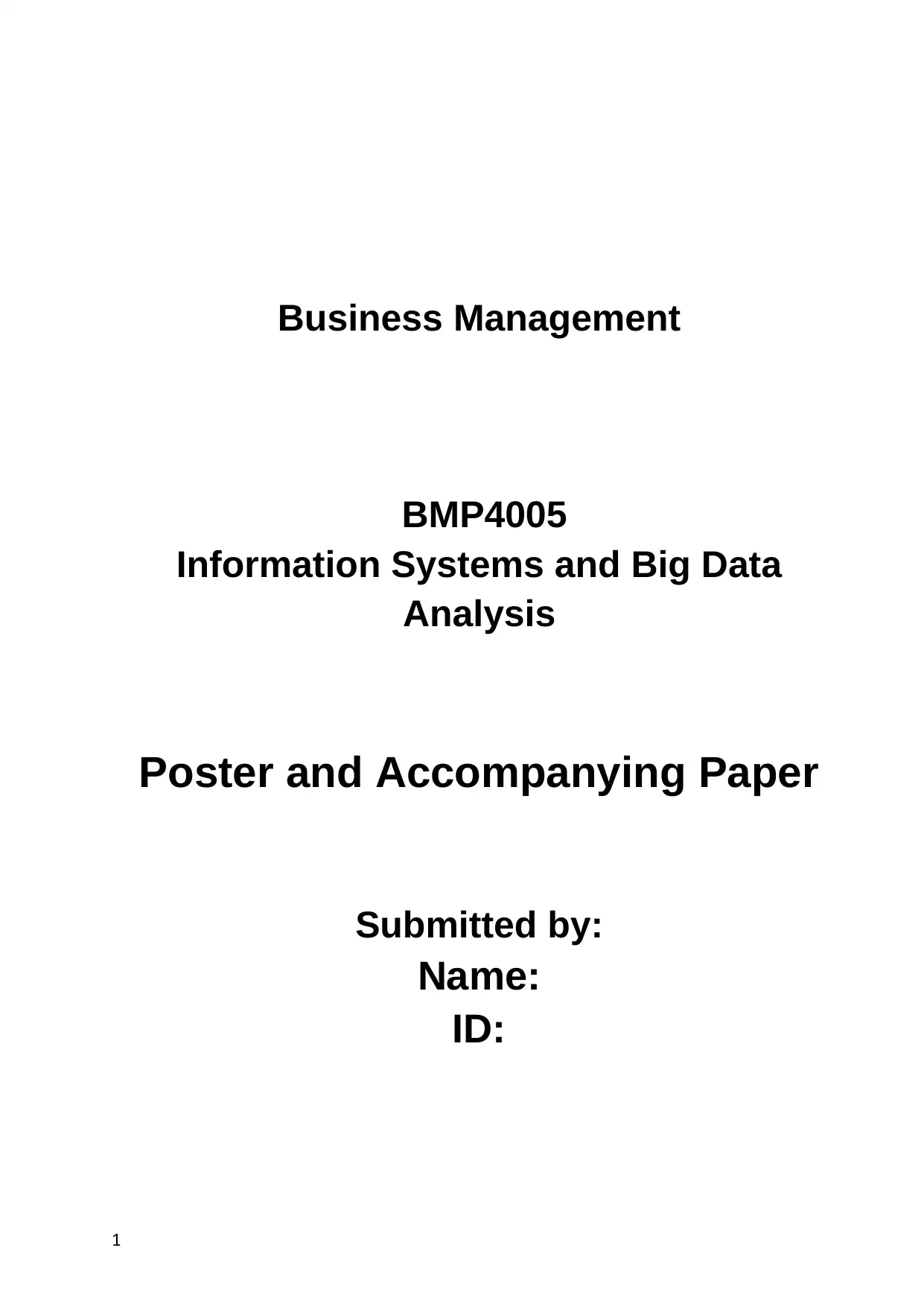
Business Management
BMP4005
Information Systems and Big Data
Analysis
Poster and Accompanying Paper
Submitted by:
Name:
ID:
1
BMP4005
Information Systems and Big Data
Analysis
Poster and Accompanying Paper
Submitted by:
Name:
ID:
1
Paraphrase This Document
Need a fresh take? Get an instant paraphrase of this document with our AI Paraphraser
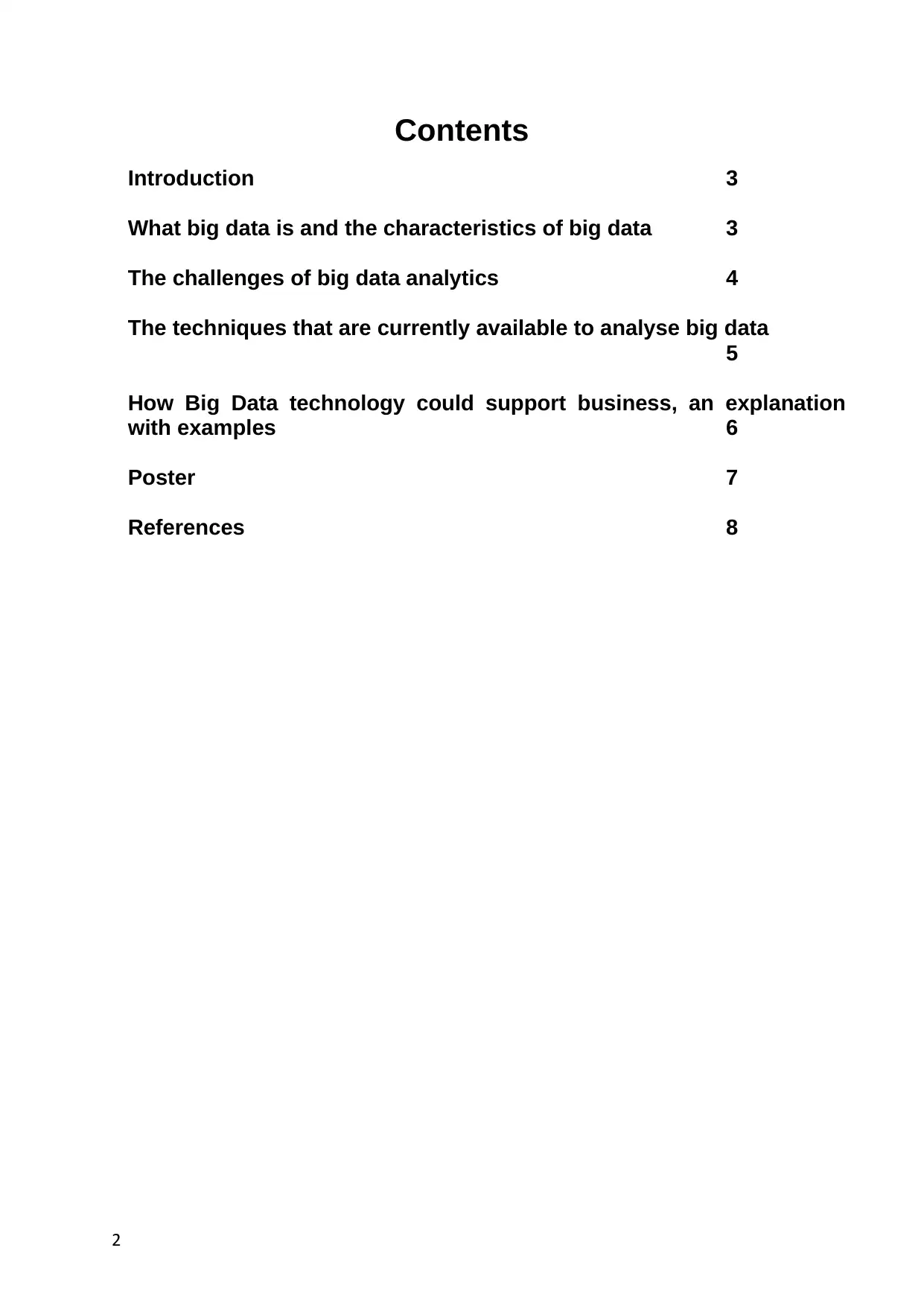
Contents
Introduction 3
What big data is and the characteristics of big data 3
The challenges of big data analytics 4
The techniques that are currently available to analyse big data
5
How Big Data technology could support business, an explanation
with examples 6
Poster 7
References 8
2
Introduction 3
What big data is and the characteristics of big data 3
The challenges of big data analytics 4
The techniques that are currently available to analyse big data
5
How Big Data technology could support business, an explanation
with examples 6
Poster 7
References 8
2
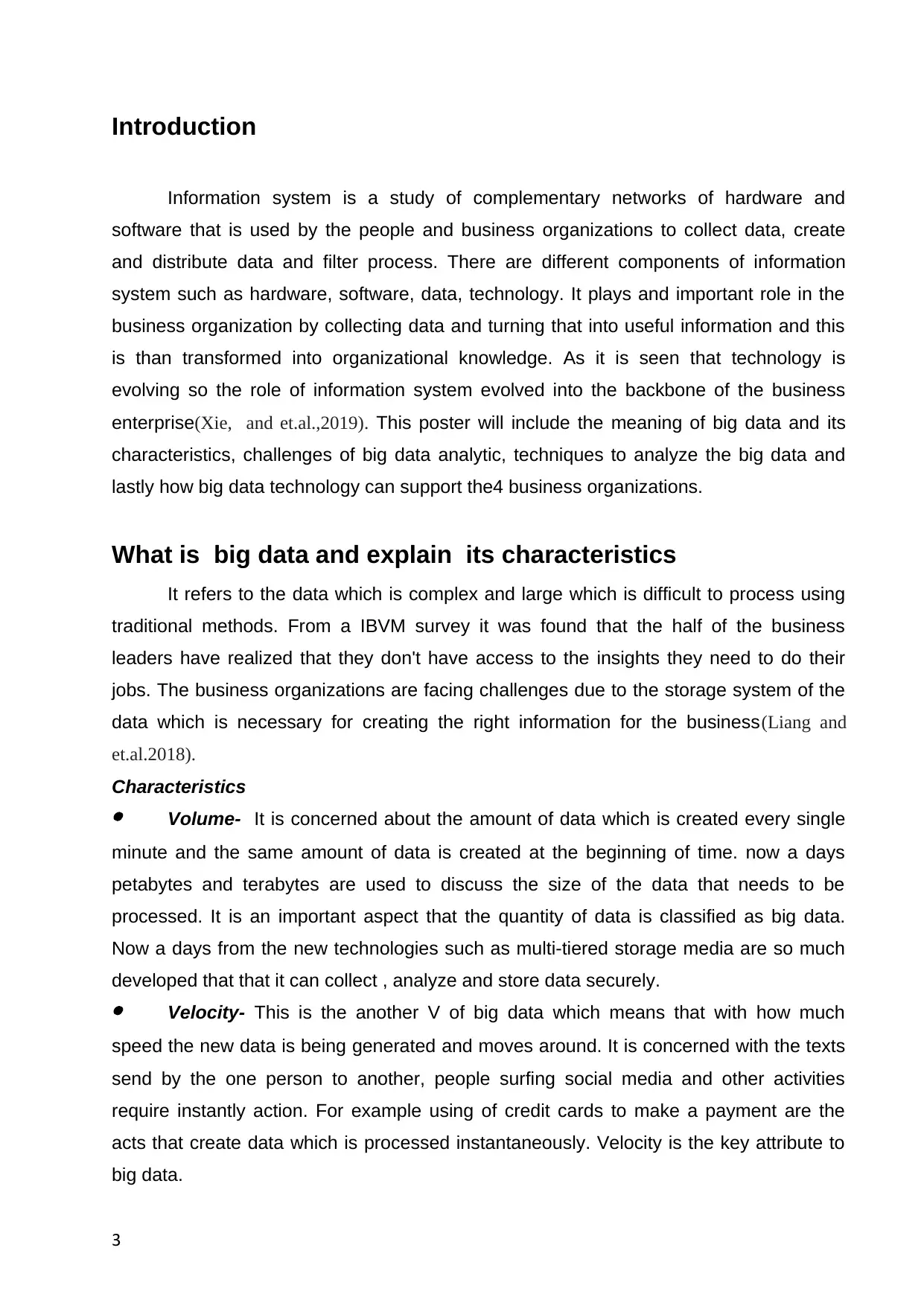
Introduction
Information system is a study of complementary networks of hardware and
software that is used by the people and business organizations to collect data, create
and distribute data and filter process. There are different components of information
system such as hardware, software, data, technology. It plays and important role in the
business organization by collecting data and turning that into useful information and this
is than transformed into organizational knowledge. As it is seen that technology is
evolving so the role of information system evolved into the backbone of the business
enterprise(Xie, and et.al.,2019). This poster will include the meaning of big data and its
characteristics, challenges of big data analytic, techniques to analyze the big data and
lastly how big data technology can support the4 business organizations.
What is big data and explain its characteristics
It refers to the data which is complex and large which is difficult to process using
traditional methods. From a IBVM survey it was found that the half of the business
leaders have realized that they don't have access to the insights they need to do their
jobs. The business organizations are facing challenges due to the storage system of the
data which is necessary for creating the right information for the business(Liang and
et.al.2018).
Characteristics Volume- It is concerned about the amount of data which is created every single
minute and the same amount of data is created at the beginning of time. now a days
petabytes and terabytes are used to discuss the size of the data that needs to be
processed. It is an important aspect that the quantity of data is classified as big data.
Now a days from the new technologies such as multi-tiered storage media are so much
developed that that it can collect , analyze and store data securely. Velocity- This is the another V of big data which means that with how much
speed the new data is being generated and moves around. It is concerned with the texts
send by the one person to another, people surfing social media and other activities
require instantly action. For example using of credit cards to make a payment are the
acts that create data which is processed instantaneously. Velocity is the key attribute to
big data.
3
Information system is a study of complementary networks of hardware and
software that is used by the people and business organizations to collect data, create
and distribute data and filter process. There are different components of information
system such as hardware, software, data, technology. It plays and important role in the
business organization by collecting data and turning that into useful information and this
is than transformed into organizational knowledge. As it is seen that technology is
evolving so the role of information system evolved into the backbone of the business
enterprise(Xie, and et.al.,2019). This poster will include the meaning of big data and its
characteristics, challenges of big data analytic, techniques to analyze the big data and
lastly how big data technology can support the4 business organizations.
What is big data and explain its characteristics
It refers to the data which is complex and large which is difficult to process using
traditional methods. From a IBVM survey it was found that the half of the business
leaders have realized that they don't have access to the insights they need to do their
jobs. The business organizations are facing challenges due to the storage system of the
data which is necessary for creating the right information for the business(Liang and
et.al.2018).
Characteristics Volume- It is concerned about the amount of data which is created every single
minute and the same amount of data is created at the beginning of time. now a days
petabytes and terabytes are used to discuss the size of the data that needs to be
processed. It is an important aspect that the quantity of data is classified as big data.
Now a days from the new technologies such as multi-tiered storage media are so much
developed that that it can collect , analyze and store data securely. Velocity- This is the another V of big data which means that with how much
speed the new data is being generated and moves around. It is concerned with the texts
send by the one person to another, people surfing social media and other activities
require instantly action. For example using of credit cards to make a payment are the
acts that create data which is processed instantaneously. Velocity is the key attribute to
big data.
3
⊘ This is a preview!⊘
Do you want full access?
Subscribe today to unlock all pages.

Trusted by 1+ million students worldwide
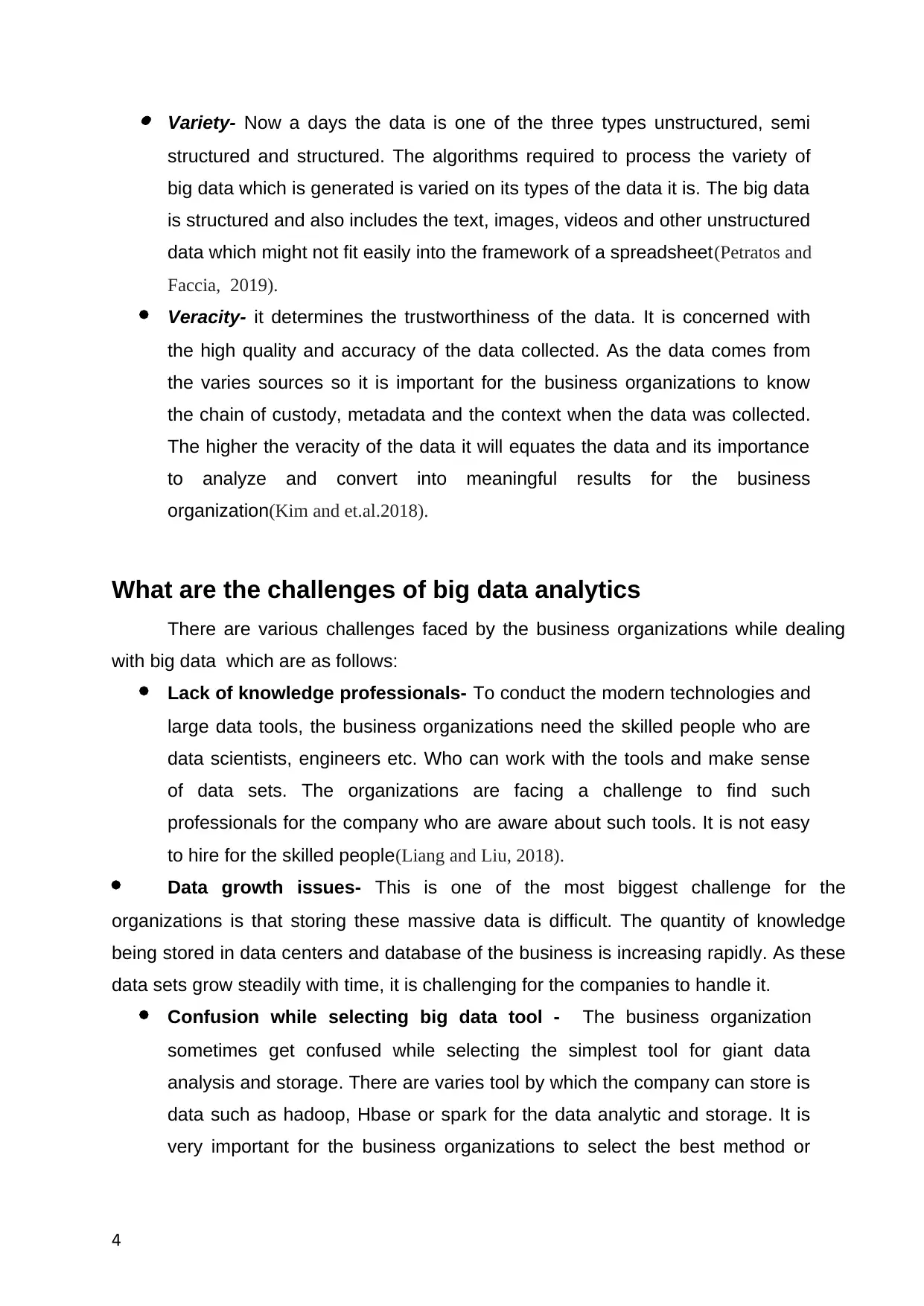
Variety- Now a days the data is one of the three types unstructured, semi
structured and structured. The algorithms required to process the variety of
big data which is generated is varied on its types of the data it is. The big data
is structured and also includes the text, images, videos and other unstructured
data which might not fit easily into the framework of a spreadsheet(Petratos and
Faccia, 2019).
Veracity- it determines the trustworthiness of the data. It is concerned with
the high quality and accuracy of the data collected. As the data comes from
the varies sources so it is important for the business organizations to know
the chain of custody, metadata and the context when the data was collected.
The higher the veracity of the data it will equates the data and its importance
to analyze and convert into meaningful results for the business
organization(Kim and et.al.2018).
What are the challenges of big data analytics
There are various challenges faced by the business organizations while dealing
with big data which are as follows:
Lack of knowledge professionals- To conduct the modern technologies and
large data tools, the business organizations need the skilled people who are
data scientists, engineers etc. Who can work with the tools and make sense
of data sets. The organizations are facing a challenge to find such
professionals for the company who are aware about such tools. It is not easy
to hire for the skilled people(Liang and Liu, 2018).
Data growth issues- This is one of the most biggest challenge for the
organizations is that storing these massive data is difficult. The quantity of knowledge
being stored in data centers and database of the business is increasing rapidly. As these
data sets grow steadily with time, it is challenging for the companies to handle it.
Confusion while selecting big data tool - The business organization
sometimes get confused while selecting the simplest tool for giant data
analysis and storage. There are varies tool by which the company can store is
data such as hadoop, Hbase or spark for the data analytic and storage. It is
very important for the business organizations to select the best method or
4
structured and structured. The algorithms required to process the variety of
big data which is generated is varied on its types of the data it is. The big data
is structured and also includes the text, images, videos and other unstructured
data which might not fit easily into the framework of a spreadsheet(Petratos and
Faccia, 2019).
Veracity- it determines the trustworthiness of the data. It is concerned with
the high quality and accuracy of the data collected. As the data comes from
the varies sources so it is important for the business organizations to know
the chain of custody, metadata and the context when the data was collected.
The higher the veracity of the data it will equates the data and its importance
to analyze and convert into meaningful results for the business
organization(Kim and et.al.2018).
What are the challenges of big data analytics
There are various challenges faced by the business organizations while dealing
with big data which are as follows:
Lack of knowledge professionals- To conduct the modern technologies and
large data tools, the business organizations need the skilled people who are
data scientists, engineers etc. Who can work with the tools and make sense
of data sets. The organizations are facing a challenge to find such
professionals for the company who are aware about such tools. It is not easy
to hire for the skilled people(Liang and Liu, 2018).
Data growth issues- This is one of the most biggest challenge for the
organizations is that storing these massive data is difficult. The quantity of knowledge
being stored in data centers and database of the business is increasing rapidly. As these
data sets grow steadily with time, it is challenging for the companies to handle it.
Confusion while selecting big data tool - The business organization
sometimes get confused while selecting the simplest tool for giant data
analysis and storage. There are varies tool by which the company can store is
data such as hadoop, Hbase or spark for the data analytic and storage. It is
very important for the business organizations to select the best method or
4
Paraphrase This Document
Need a fresh take? Get an instant paraphrase of this document with our AI Paraphraser
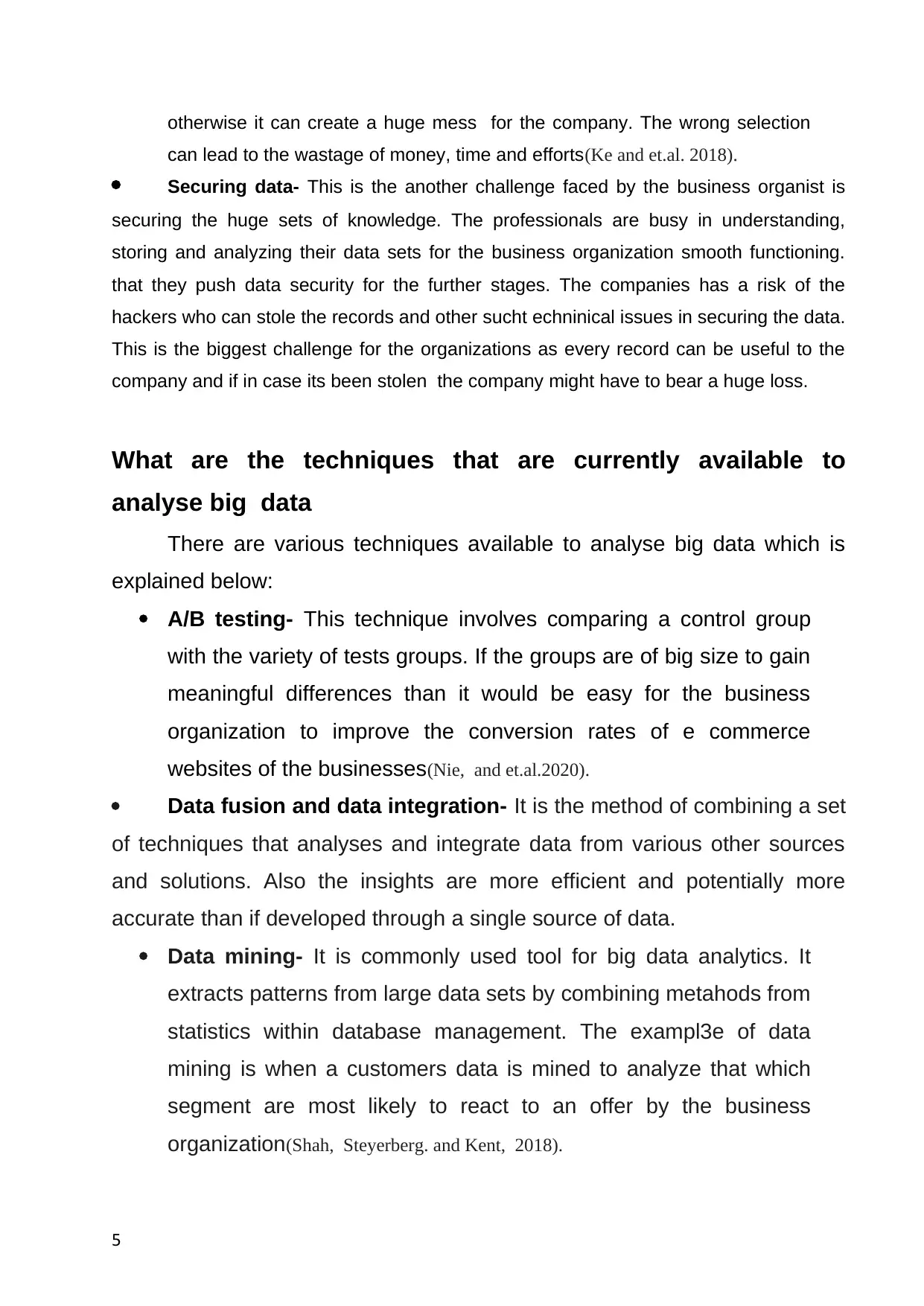
otherwise it can create a huge mess for the company. The wrong selection
can lead to the wastage of money, time and efforts(Ke and et.al. 2018).
Securing data- This is the another challenge faced by the business organist is
securing the huge sets of knowledge. The professionals are busy in understanding,
storing and analyzing their data sets for the business organization smooth functioning.
that they push data security for the further stages. The companies has a risk of the
hackers who can stole the records and other sucht echninical issues in securing the data.
This is the biggest challenge for the organizations as every record can be useful to the
company and if in case its been stolen the company might have to bear a huge loss.
What are the techniques that are currently available to
analyse big data
There are various techniques available to analyse big data which is
explained below:
A/B testing- This technique involves comparing a control group
with the variety of tests groups. If the groups are of big size to gain
meaningful differences than it would be easy for the business
organization to improve the conversion rates of e commerce
websites of the businesses(Nie, and et.al.2020).
Data fusion and data integration- It is the method of combining a set
of techniques that analyses and integrate data from various other sources
and solutions. Also the insights are more efficient and potentially more
accurate than if developed through a single source of data.
Data mining- It is commonly used tool for big data analytics. It
extracts patterns from large data sets by combining metahods from
statistics within database management. The exampl3e of data
mining is when a customers data is mined to analyze that which
segment are most likely to react to an offer by the business
organization(Shah, Steyerberg. and Kent, 2018).
5
can lead to the wastage of money, time and efforts(Ke and et.al. 2018).
Securing data- This is the another challenge faced by the business organist is
securing the huge sets of knowledge. The professionals are busy in understanding,
storing and analyzing their data sets for the business organization smooth functioning.
that they push data security for the further stages. The companies has a risk of the
hackers who can stole the records and other sucht echninical issues in securing the data.
This is the biggest challenge for the organizations as every record can be useful to the
company and if in case its been stolen the company might have to bear a huge loss.
What are the techniques that are currently available to
analyse big data
There are various techniques available to analyse big data which is
explained below:
A/B testing- This technique involves comparing a control group
with the variety of tests groups. If the groups are of big size to gain
meaningful differences than it would be easy for the business
organization to improve the conversion rates of e commerce
websites of the businesses(Nie, and et.al.2020).
Data fusion and data integration- It is the method of combining a set
of techniques that analyses and integrate data from various other sources
and solutions. Also the insights are more efficient and potentially more
accurate than if developed through a single source of data.
Data mining- It is commonly used tool for big data analytics. It
extracts patterns from large data sets by combining metahods from
statistics within database management. The exampl3e of data
mining is when a customers data is mined to analyze that which
segment are most likely to react to an offer by the business
organization(Shah, Steyerberg. and Kent, 2018).
5
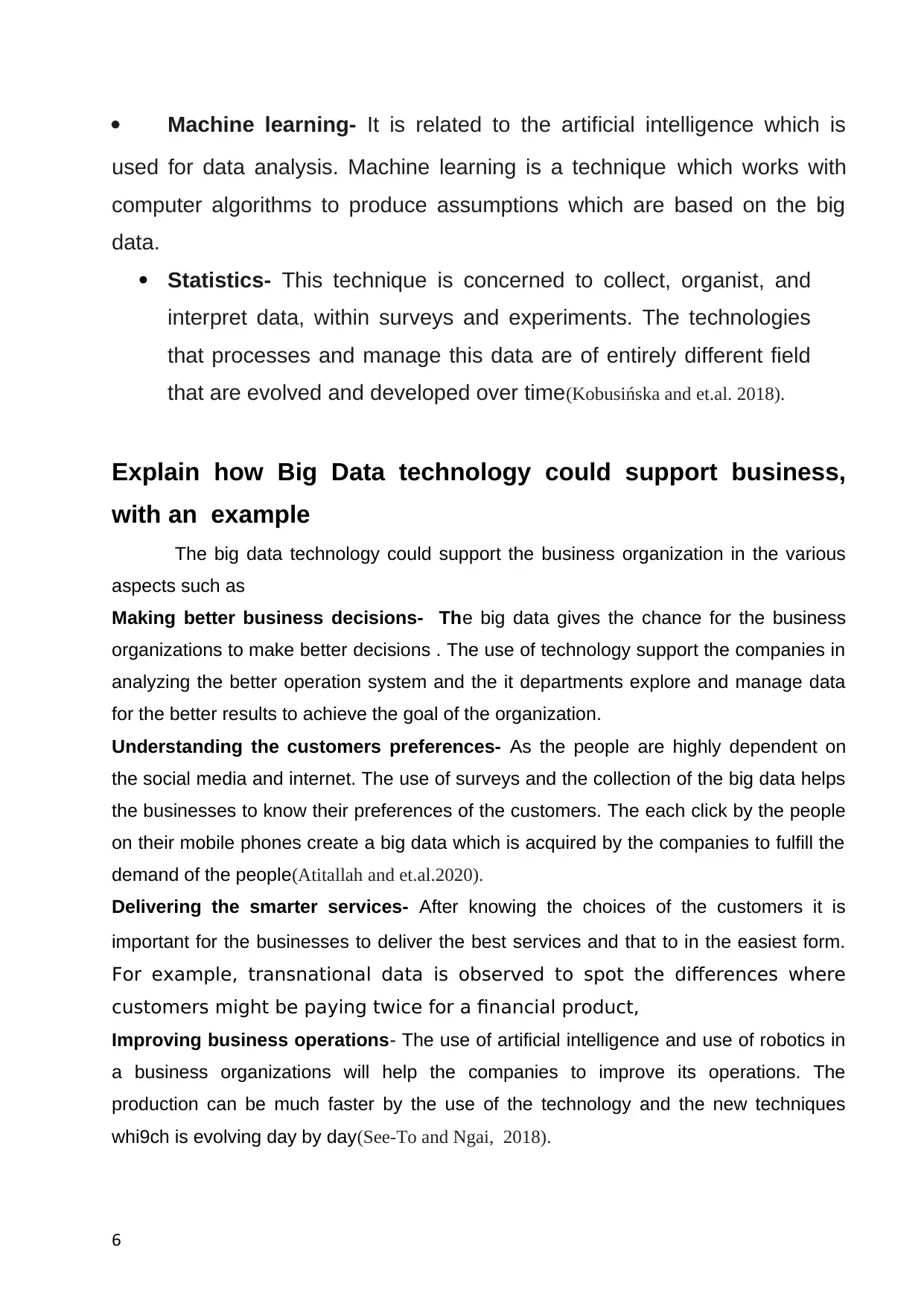
Machine learning- It is related to the artificial intelligence which is
used for data analysis. Machine learning is a technique which works with
computer algorithms to produce assumptions which are based on the big
data.
Statistics- This technique is concerned to collect, organist, and
interpret data, within surveys and experiments. The technologies
that processes and manage this data are of entirely different field
that are evolved and developed over time(Kobusińska and et.al. 2018).
Explain how Big Data technology could support business,
with an example
The big data technology could support the business organization in the various
aspects such as
Making better business decisions- The big data gives the chance for the business
organizations to make better decisions . The use of technology support the companies in
analyzing the better operation system and the it departments explore and manage data
for the better results to achieve the goal of the organization.
Understanding the customers preferences- As the people are highly dependent on
the social media and internet. The use of surveys and the collection of the big data helps
the businesses to know their preferences of the customers. The each click by the people
on their mobile phones create a big data which is acquired by the companies to fulfill the
demand of the people(Atitallah and et.al.2020).
Delivering the smarter services- After knowing the choices of the customers it is
important for the businesses to deliver the best services and that to in the easiest form.
For example, transnational data is observed to spot the differences where
customers might be paying twice for a financial product,
Improving business operations- The use of artificial intelligence and use of robotics in
a business organizations will help the companies to improve its operations. The
production can be much faster by the use of the technology and the new techniques
whi9ch is evolving day by day(See-To and Ngai, 2018).
6
used for data analysis. Machine learning is a technique which works with
computer algorithms to produce assumptions which are based on the big
data.
Statistics- This technique is concerned to collect, organist, and
interpret data, within surveys and experiments. The technologies
that processes and manage this data are of entirely different field
that are evolved and developed over time(Kobusińska and et.al. 2018).
Explain how Big Data technology could support business,
with an example
The big data technology could support the business organization in the various
aspects such as
Making better business decisions- The big data gives the chance for the business
organizations to make better decisions . The use of technology support the companies in
analyzing the better operation system and the it departments explore and manage data
for the better results to achieve the goal of the organization.
Understanding the customers preferences- As the people are highly dependent on
the social media and internet. The use of surveys and the collection of the big data helps
the businesses to know their preferences of the customers. The each click by the people
on their mobile phones create a big data which is acquired by the companies to fulfill the
demand of the people(Atitallah and et.al.2020).
Delivering the smarter services- After knowing the choices of the customers it is
important for the businesses to deliver the best services and that to in the easiest form.
For example, transnational data is observed to spot the differences where
customers might be paying twice for a financial product,
Improving business operations- The use of artificial intelligence and use of robotics in
a business organizations will help the companies to improve its operations. The
production can be much faster by the use of the technology and the new techniques
whi9ch is evolving day by day(See-To and Ngai, 2018).
6
⊘ This is a preview!⊘
Do you want full access?
Subscribe today to unlock all pages.

Trusted by 1+ million students worldwide
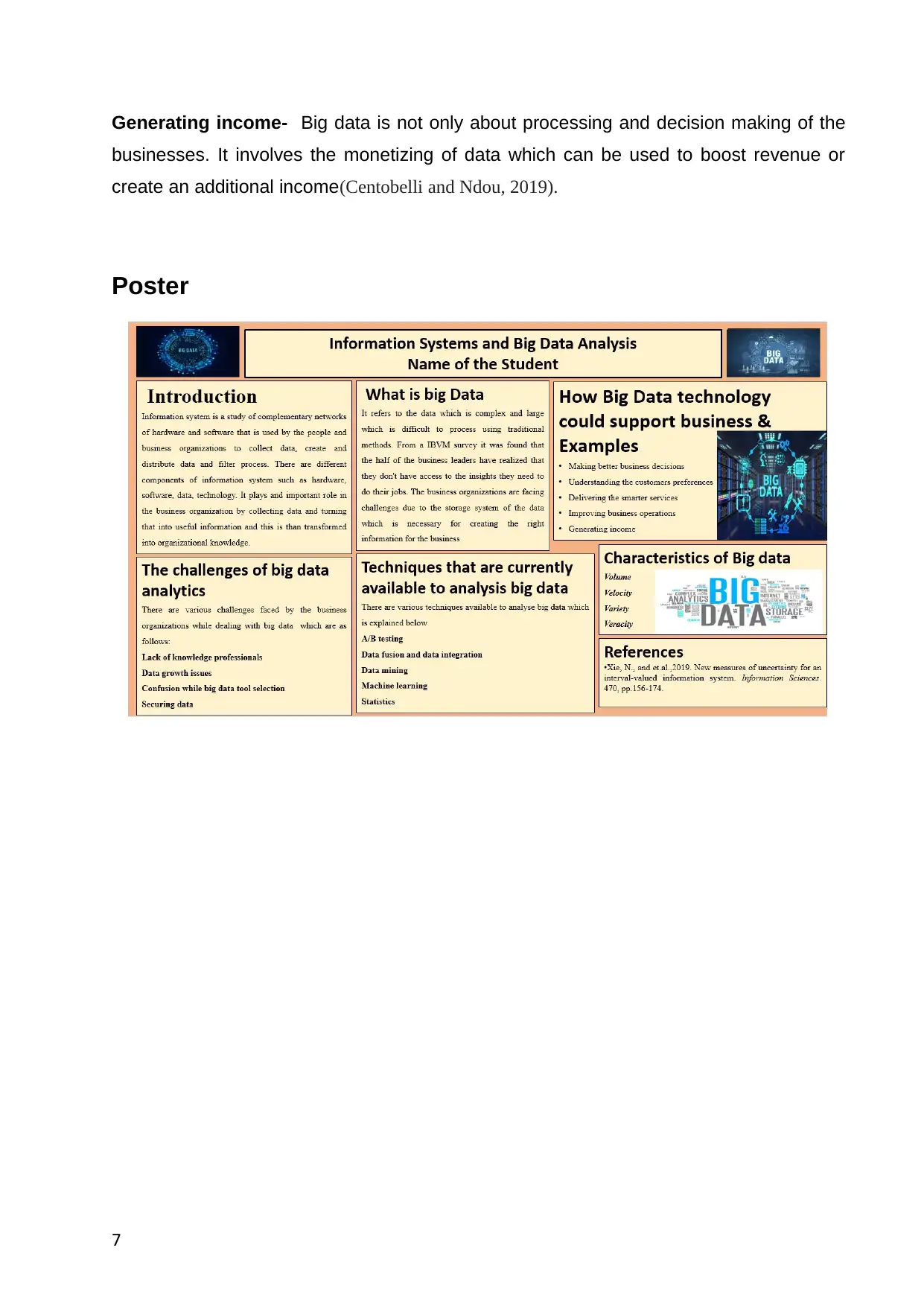
Generating income- Big data is not only about processing and decision making of the
businesses. It involves the monetizing of data which can be used to boost revenue or
create an additional income(Centobelli and Ndou, 2019).
Poster
7
businesses. It involves the monetizing of data which can be used to boost revenue or
create an additional income(Centobelli and Ndou, 2019).
Poster
7
Paraphrase This Document
Need a fresh take? Get an instant paraphrase of this document with our AI Paraphraser
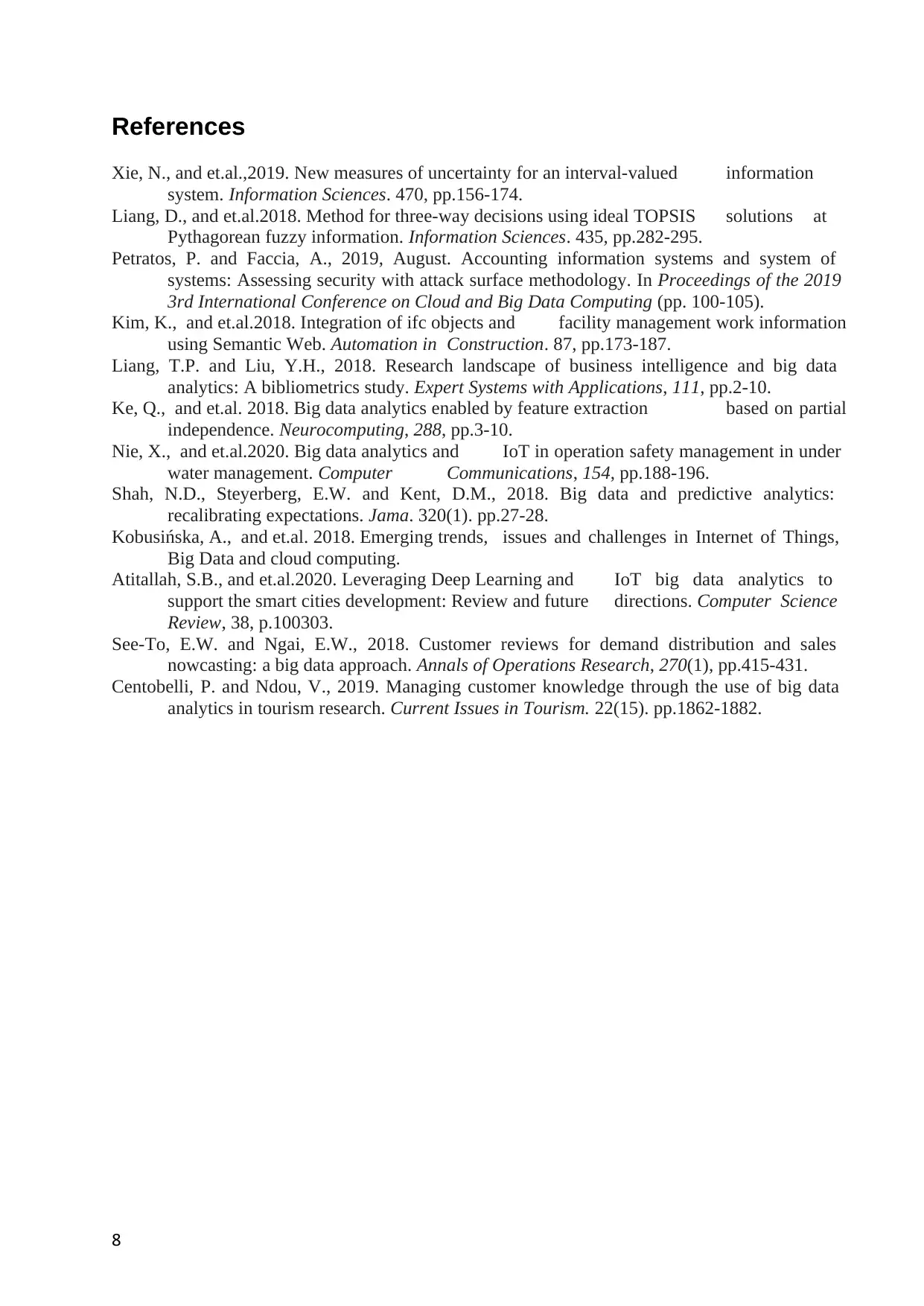
References
Xie, N., and et.al.,2019. New measures of uncertainty for an interval-valued information
system. Information Sciences. 470, pp.156-174.
Liang, D., and et.al.2018. Method for three-way decisions using ideal TOPSIS solutions at
Pythagorean fuzzy information. Information Sciences. 435, pp.282-295.
Petratos, P. and Faccia, A., 2019, August. Accounting information systems and system of
systems: Assessing security with attack surface methodology. In Proceedings of the 2019
3rd International Conference on Cloud and Big Data Computing (pp. 100-105).
Kim, K., and et.al.2018. Integration of ifc objects and facility management work information
using Semantic Web. Automation in Construction. 87, pp.173-187.
Liang, T.P. and Liu, Y.H., 2018. Research landscape of business intelligence and big data
analytics: A bibliometrics study. Expert Systems with Applications, 111, pp.2-10.
Ke, Q., and et.al. 2018. Big data analytics enabled by feature extraction based on partial
independence. Neurocomputing, 288, pp.3-10.
Nie, X., and et.al.2020. Big data analytics and IoT in operation safety management in under
water management. Computer Communications, 154, pp.188-196.
Shah, N.D., Steyerberg, E.W. and Kent, D.M., 2018. Big data and predictive analytics:
recalibrating expectations. Jama. 320(1). pp.27-28.
Kobusińska, A., and et.al. 2018. Emerging trends, issues and challenges in Internet of Things,
Big Data and cloud computing.
Atitallah, S.B., and et.al.2020. Leveraging Deep Learning and IoT big data analytics to
support the smart cities development: Review and future directions. Computer Science
Review, 38, p.100303.
See-To, E.W. and Ngai, E.W., 2018. Customer reviews for demand distribution and sales
nowcasting: a big data approach. Annals of Operations Research, 270(1), pp.415-431.
Centobelli, P. and Ndou, V., 2019. Managing customer knowledge through the use of big data
analytics in tourism research. Current Issues in Tourism. 22(15). pp.1862-1882.
8
Xie, N., and et.al.,2019. New measures of uncertainty for an interval-valued information
system. Information Sciences. 470, pp.156-174.
Liang, D., and et.al.2018. Method for three-way decisions using ideal TOPSIS solutions at
Pythagorean fuzzy information. Information Sciences. 435, pp.282-295.
Petratos, P. and Faccia, A., 2019, August. Accounting information systems and system of
systems: Assessing security with attack surface methodology. In Proceedings of the 2019
3rd International Conference on Cloud and Big Data Computing (pp. 100-105).
Kim, K., and et.al.2018. Integration of ifc objects and facility management work information
using Semantic Web. Automation in Construction. 87, pp.173-187.
Liang, T.P. and Liu, Y.H., 2018. Research landscape of business intelligence and big data
analytics: A bibliometrics study. Expert Systems with Applications, 111, pp.2-10.
Ke, Q., and et.al. 2018. Big data analytics enabled by feature extraction based on partial
independence. Neurocomputing, 288, pp.3-10.
Nie, X., and et.al.2020. Big data analytics and IoT in operation safety management in under
water management. Computer Communications, 154, pp.188-196.
Shah, N.D., Steyerberg, E.W. and Kent, D.M., 2018. Big data and predictive analytics:
recalibrating expectations. Jama. 320(1). pp.27-28.
Kobusińska, A., and et.al. 2018. Emerging trends, issues and challenges in Internet of Things,
Big Data and cloud computing.
Atitallah, S.B., and et.al.2020. Leveraging Deep Learning and IoT big data analytics to
support the smart cities development: Review and future directions. Computer Science
Review, 38, p.100303.
See-To, E.W. and Ngai, E.W., 2018. Customer reviews for demand distribution and sales
nowcasting: a big data approach. Annals of Operations Research, 270(1), pp.415-431.
Centobelli, P. and Ndou, V., 2019. Managing customer knowledge through the use of big data
analytics in tourism research. Current Issues in Tourism. 22(15). pp.1862-1882.
8
1 out of 8
Related Documents
Your All-in-One AI-Powered Toolkit for Academic Success.
+13062052269
info@desklib.com
Available 24*7 on WhatsApp / Email
![[object Object]](/_next/static/media/star-bottom.7253800d.svg)
Unlock your academic potential
Copyright © 2020–2025 A2Z Services. All Rights Reserved. Developed and managed by ZUCOL.
